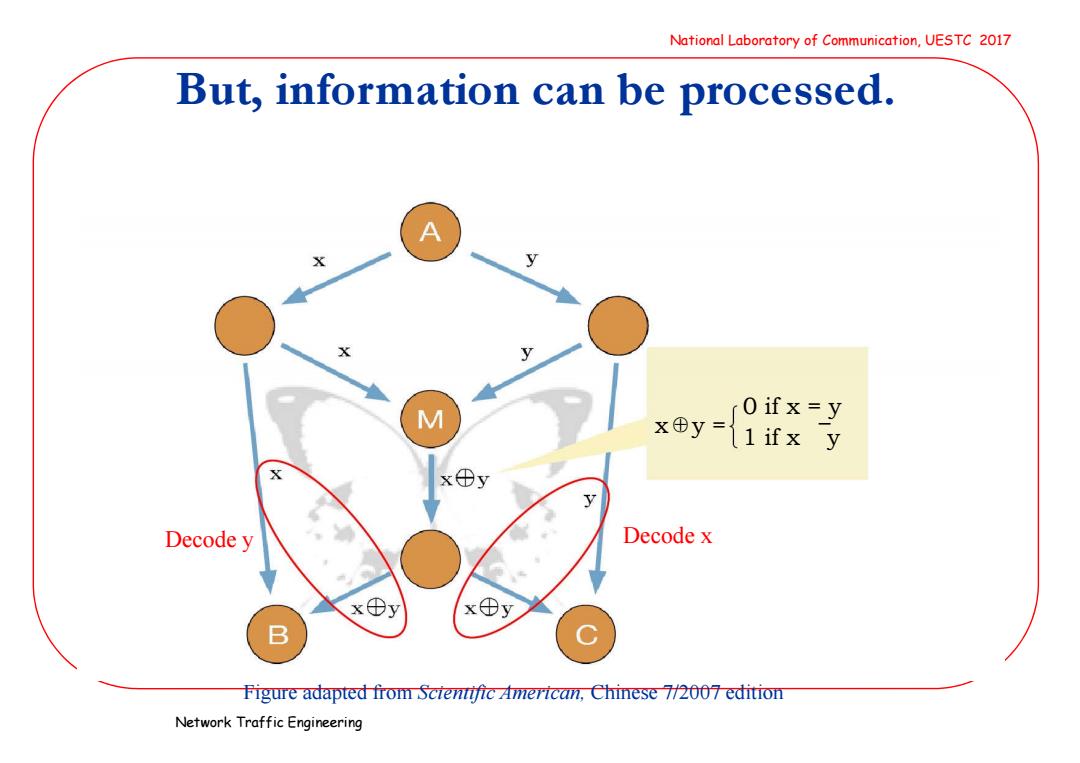
National Laboratory of Communication,UESTC 2017 Network Coding and Traffic Balancing Network Traffic Engineering O:Introduction Page.1
Network Traffic Engineering National Laboratory of Communication, UESTC 2017 0: Introduction Page.1 Network Coding and Traffic Balancing

National Laboratory of Communication,UESTC 2017 Overview Chap 10:Introduction to Network Coding Chap 11:Network Coding in Wireless Networks Chap 12:A Practical Network Coding System Network Traffic Engineering O:Introduction Page.2
Network Traffic Engineering National Laboratory of Communication, UESTC 2017 0: Introduction Page.2 • Chap 10: Introduction to Network Coding • Chap 11: Network Coding in Wireless Networks • Chap 12: A Practical Network Coding System

National Laboratory of Communication,UESTC 2017 Chap 10:Introduction to Network Coding Network Coding (NC) A brief intro to NC-A Chinese-based creative tech in network communication Basic theory of Linear NC Algebraic construction of Linear NC Illustration of Linear NC in wired networks Network Traffic Engineering O:Introduction Page.3
Network Traffic Engineering National Laboratory of Communication, UESTC 2017 0: Introduction Page.3 Chap 10: Introduction to Network Coding • Network Coding (NC) - A brief intro to NC – A Chinese-based creative tech in network communication - Basic theory of Linear NC - Algebraic construction of Linear NC - Illustration of Linear NC in wired networks

National Laboratory of Communication,UESTC 2017 What is network coding (NC)? NC vs.store-and-forward Network Traffic Engineering
Network Traffic Engineering National Laboratory of Communication, UESTC 2017 5 What is network coding (NC)? NC vs. store-and-forward

National Laboratory of Communication,UESTC 2017 Store-and-forward Conventional mode of transport Parcels Transportation network Cargo shipment 200时4/H Network Traffic Engineering
Network Traffic Engineering National Laboratory of Communication, UESTC 2017 6 Store-and-forward Conventional mode of transport Parcels Transportation network Cargo shipment 2010/4/1

National Laboratory of Communication,UESTC 2017 The store-and-forward mode is inherited by telecommunications. Internet 2010f41 Network Traffic Engineering
Network Traffic Engineering National Laboratory of Communication, UESTC 2017 7 The store-and-forward mode is inherited by telecommunications. Internet 2010/4/1

National Laboratory of Communication,UESTC 2017 Treating information like parcel A x=0 or 1 y=0or 1 Every channels transmits one bit. M Oif x=y x⊕y= 1ifx y Either x ory Store-and-forward B Figure adapted from Scientific American,Chinese 7/2007 edition Network Traffic Engineering
Network Traffic Engineering National Laboratory of Communication, UESTC 2017 0 if x = y x⊕y = Treating information like parcel x = 0 or 1 y = 0 or 1 Every channels transmits one bit. Store-and-forward 1 if x y Either x or y Figure adapted from Scientific American, Chinese 7/2007 edition

National Laboratory of Communication,UESTC 2017 Treating information like parcel A 数十 Traffic jam B Figure adapted from Scienific American,Chinese 7/2007 edition Network Traffic Engineering
Network Traffic Engineering National Laboratory of Communication, UESTC 2017 Treating information like parcel Traffic jam Figure adapted from Scientific American, Chinese 7/2007 edition

National Laboratory of Communication,UESTC 2017 But,information can be processed. A M 0ifx=y x⊕y=11fx y x⊕y B Figure adapted from Scienific American,Chinese 7/2007 edition Network Traffic Engineering
Network Traffic Engineering National Laboratory of Communication, UESTC 2017 But, information can be processed. x⊕y = 0 if x = y 1 if x y Figure adapted from Scientific American, Chinese 7/2007 edition

National Laboratory of Communication,UESTC 2017 But,information can be processed. A M 0ifx=y x⊕y={1fx y x⊕y Decode y Decode x x⊕y x⊕y B Figure adapted from Scienific American,Chinese 7/2007 edition Network Traffic Engineering
Network Traffic Engineering National Laboratory of Communication, UESTC 2017 But, information can be processed. x⊕y = 0 if x = y 1 if x y Decode y Decode x Figure adapted from Scientific American, Chinese 7/2007 edition